Disclaimer: Please note I receive a small commission when you purchase from some of the links on this page. You don't pay more when you buy through me; it simply gives me a chance to offer you all this great content for free!
Venture into the vast expanse of the Bolivia Salt Flats, covering an impressive 10,000 km² and perched at a lofty altitude of 3,653 meters, an iconic jewel of South America’s natural wonders.
As you traverse this endless white desert, seize the opportunity to craft whimsical photos that defy proportions, turning ordinary scenes into extraordinary memories. Yet, the Salt Flats are not just a photographer’s paradise; they stand as a testament to Bolivia’s rich economic tapestry, contributing immensely with its vast lithium reserves and annual 25,000 tons of salt production.
Delve deeper into its history, and you’ll discover a once-massive lake that existed over 10,000 years ago, now known for its captivating mirror effects during the rainy season. And as you journey, don’t miss the quaint town of Colchani, where the age-old tradition of salt production comes to life.
Naturally, these would steal the show, but we were totally wrong! In the end the Salar de Uyuni was impressive but there are so many more amazing natural treasures to discover! You don’t believe me? Then read this post!
Liane’s TL;DR for Salar de Uyuni
- Expansive Beauty: The Bolivia Salt Flats span a staggering 10,000 km² at 3,653 meters altitude, showcasing nature’s grandeur.
- More Than Meets the Eye: Beyond the stunning visuals, the Salt Flats play a pivotal role in Bolivia’s economy with its abundant lithium and annual salt production.
- Historical & Cultural Depths: From its origins as a gigantic lake to the salt-producing heart of Colchani, a rich tapestry of stories is waiting to be discovered.
Understanding Bolivia Salt Flats
Economically, the Salar de Uyuni still plays an important role in Bolivia as it is one of the biggest lithium sources in the world, used for batteries. 25,000 tons of salt are removed and brought into the cities every year.

The Salt Flats in Bolivia is a vast, white, and endless salt flat that is over 10 meters thick and is located in the center of the Salar de Uyuni.
More than 10,000 years ago, the whole area was a huge lake before it dried out. The Salar de Uyuni is also known for creating a natural mirror effect during the rainy season, which falls between January and April. The salt flat floods during this period, creating a stunning crystallized salt pattern.
Colchani and the Railroad
Colchani is a very tiny, one street town, that doesn’t seem to be more than a tourist trap where you can buy colorful souvenirs. But this village plays an important role for the locals. The few houses are the production place of table salt.
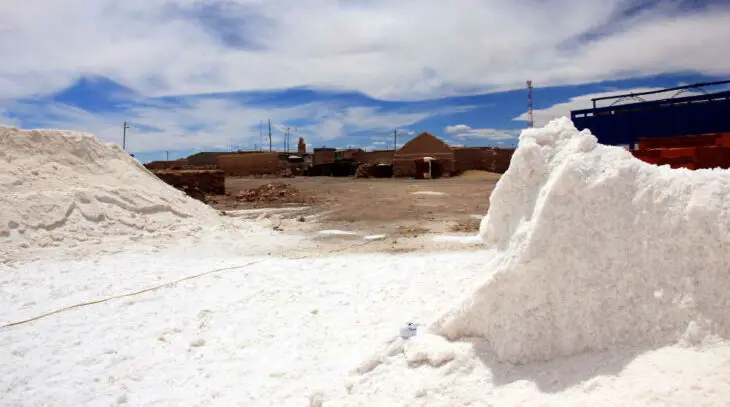
After removing the salt from the salt flat and drying it in the sun for a few days, it is further dried in an oven and enriched with iodine. Then the salt is milled and ready is the Salar de Uyuni table salt.
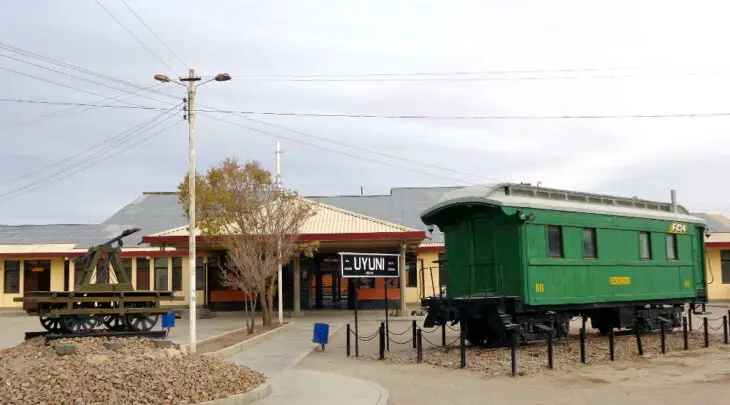
When you walk through the village you will discover piles of salt ready to be processed. Have a closer look at he bricks of the houses. Guess of what material they are made of!
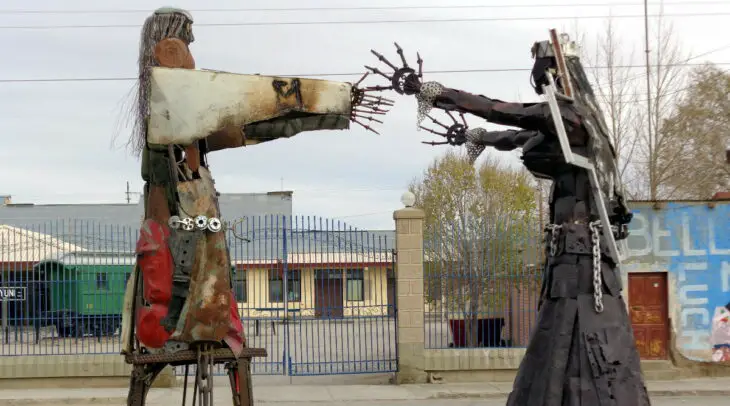
Planning Your Trip
When planning a trip to Bolivia’s Salt Flats, several factors must be considered to ensure a memorable and enjoyable experience. Here are some tips to help you plan your trip:
Best Time to Visit
The best time to visit Bolivia’s Salt Flats is during the dry season, which runs from May to November. The weather is dry and sunny during this time, making it ideal for exploring the Salt Flats. However, keep in mind that the temperature can drop significantly at night, so make sure to pack warm clothes.
Tour Operators
Several tour operators in Bolivia offer trips to the Salt Flats. It’s important to choose a reputable tour company that has experience in organizing trips to this area. Depending on your preferences, you can choose between a group tour or a private one.
Itinerary
When planning your itinerary, consider how much time you have and what activities you want to do. Most tours to the Salt Flats are four-day tours, which typically include a visit to the Salt Flats on the final day. However, day trips are also available if you’re short on time.
Altitude Sickness
The Salt Flats are located at a high altitude, so taking precautions is important to avoid altitude sickness. Make sure to drink plenty of water, avoid alcohol and caffeine, and take it easy for the first few days to allow your body to acclimate to the altitude.
Overall, planning a trip to Bolivia’s Salt Flats requires careful consideration of several factors. By choosing the right time to visit, a reputable tour operator, and taking proper precautions, you can ensure a safe and unforgettable experience.
Best Seasons to Visit
Wet Season Advantages
The wet season in Bolivia runs from December to March. During this time, the valleys are lush and green, and the salt flats are transformed into a giant mirror, creating a stunning and unique natural phenomenon. The increased rainfall also means that the rivers are full, providing water-based activities such as swimming, rafting, and kayaking.
Dry Season Advantages
The dry season in Bolivia runs from May to November. This is the best time to visit the salt flats for many tourists, as the clear skies and sunny weather make for ideal conditions for taking photographs and exploring the region. It’s also the shoulder season for tourism, meaning that there are fewer crowds and lower prices than during the rainy season.
Overall, the best time to visit Bolivia’s salt flats depends on what you want to experience. If you want to see the mirror effect and enjoy water-based activities, then the wet season is the best time to go. However, if you want to take advantage of the clear skies and lower prices, then the dry season is the best time to visit. Regardless of when you go, be sure to pack warm clothing as temperatures can drop significantly, especially at night, during both the winter and summer seasons.
Unique Phenomenon: The Mirror Effect
When you visit the Bolivia Salt Flats, you can witness a unique phenomenon known as the Mirror Effect. This phenomenon occurs during the rainy season between December and April. During this time, the salt flats are covered with a thin layer of water, which creates a mirror-like effect. This effect is caused by the reflection of the sky on the water, making it seem like the sky and the ground are one.
As you can tell from our photos, we were there during the dry season, but we are told the Mirror Effect is a breathtaking sight to see, and it is the main reason why many people choose to visit the Bolivia Salt Flats during the rainy season. It is an excellent opportunity to capture some stunning photos that will leave you in awe.
However, it is worth noting that the Mirror Effect is not guaranteed during the rainy season. It depends on the amount of rain the region receives. If there is too much rain, the salt flats may flood, and the Mirror Effect may not occur. Therefore, planning your trip accordingly and keeping an eye on the weather forecast is essential.
Accommodation and Travel Arrangements
When planning a trip to Bolivia to visit the salt flats, there are several accommodations and travel arrangements to consider. Here are some important details to keep in mind:
Hotels and Salt Hotels
A variety of hotels and salt hotels are available in the area surrounding the salt flats. Some hotels are located in the nearby town of Uyuni, while others are situated directly on the salt flats themselves. Salt hotels, as the name suggests, are made entirely out of salt and offer visitors a unique and memorable experience. It is important to book accommodations in advance, especially during the peak travel season.
Accommodation
In addition to hotels and salt hotels, there are also options for camping or staying in a hostel. Camping can be a great way to experience the natural beauty of the salt flats, but it is important to come prepared with appropriate gear and supplies. Hostels can be a more affordable option for budget-conscious travelers.
Flights
The closest major airport to the salt flats is located in the city of La Paz, which is approximately a 10-hour drive from Uyuni. There are also smaller airports located in nearby towns, such as Potosi and Sucre, which offer domestic flights. It is important to book flights in advance and be aware of any baggage restrictions.
Night Buses
Another option for travel to Uyuni is by night bus. This can be a more affordable option for travelers on a budget, but it is important to book tickets in advance and be prepared for a long journey.
Overall, when planning a trip to the Bolivia salt flats, it is important to consider all available accommodations and travel options to make the most of your experience. We can ensure a smooth and enjoyable trip by booking in advance and being prepared for the journey.
Important Accessories for the Trip
When planning a trip to Bolivia’s Salt Flats, there are a few important accessories that we should consider bringing along. These accessories can help us stay comfortable and safe during our visit. Here are some of the most important ones:
Hat
A hat is an essential accessory for protecting our head and face from the sun’s rays. The high altitude and proximity to the equator can make the sun’s rays particularly intense, so it’s important to choose a hat with a wide brim that can provide ample shade.
Sunscreen
Sunscreen is another must-have accessory for protecting our skin from the sun’s harmful rays. We should choose a sunscreen with a high SPF rating and apply it generously and frequently throughout the day.
Sunglasses
Sunglasses are important for protecting our eyes from the bright sunlight and glare on the salt flats. We should choose sunglasses with polarized lenses that can reduce glare and provide clear vision.
Gloves
Gloves are important for keeping our hands warm and protected from the cold and wind on the salt flats. We should choose gloves that are warm and waterproof, as the salt flats can be quite chilly and wet.
Layers
The weather on the salt flats can be unpredictable, with temperatures ranging from hot and sunny to cold and windy. It’s important to dress in layers so that we can adjust our clothing as needed to stay comfortable.
Sleeping Bag
When you have a sleeping bag, you should bring one. Especially the second night is very cold. If you don’t have one, bring more clothes for the night or rent a sleeping bag.
Bucket List
Finally, it’s important to bring along a bucket list of the things we want to see and do on the salt flats. This can help us prioritize our time and make sure we don’t miss any of the highlights of this incredible destination.
By packing these important accessories, we can ensure that we have a safe, comfortable, and enjoyable trip to Bolivia’s Salt Flats.
Batteries and Charging Packs
You will take hundreds of pictures and the cold weather will empty the batteries much faster.
Tip: Put your batteries into your sleeping bag at night so that they stay warm and don’t lose energy. It really helps.
Exploring the Surrounding Areas
When planning a trip to the Bolivia Salt Flats, it’s important to consider the surrounding areas as well. There are several cities and attractions that are worth visiting while in the region.
La Paz, the administrative capital of Bolivia, is a bustling city located in the highlands. It’s a great place to start your journey to the salt flats as it offers a variety of transportation options. From La Paz, you can take a bus or a flight to Uyuni, the gateway to the salt flats.
San Pedro de Atacama, located just across the border in Chile, is another popular destination for those visiting the salt flats. This small town is known for its stunning landscapes and unique geological formations. It’s a great place to spend a few days before or after your trip to the salt flats.
Tupiza, a small town located in the south of Bolivia, is another great option for those looking to explore the region. It’s known for its stunning red rock formations and is a popular starting point for tours to the salt flats.
If you’re coming from Argentina, Oruro is a great place to stop and explore before continuing on to the salt flats. This city is known for its vibrant Carnaval celebrations and is a great place to experience Bolivian culture.
Overall, the best time to visit the Bolivia Salt Flats is during the dry season from May to October. However, it’s important to consider the weather conditions in the surrounding areas as well. The highlands can be cold and windy, so be sure to pack warm clothing and layers. Additionally, it’s important to plan your transportation and accommodations in advance as they can fill up quickly during peak season.
Precautions and Safety Measures
When planning a trip to the Bolivia Salt Flats, it is important to take certain precautions and safety measures to ensure a safe and enjoyable experience. Here are some tips to keep in mind:
- Altitude Sickness: The Bolivia Salt Flats are located at a very high altitude, which can cause altitude sickness in some people. To prevent altitude sickness, it is recommended to acclimate to the altitude gradually by spending a few days in a nearby town before heading to the salt flats. It is also important to stay hydrated and avoid alcohol and strenuous exercise.
- Safe Tours: When choosing a tour company to visit the salt flats, it is important to do your research and read reviews to ensure that the company is reputable and safe. Look for companies that have experienced guides, well-maintained vehicles, and safety equipment such as oxygen tanks.
- Vehicle Safety: When traveling on the salt flats, it is important to stay on designated paths and avoid driving on areas that are not safe. The salt flats can be unpredictable and vehicles can easily get stuck in mud or sinkholes. Make sure that the tour company you choose has well-maintained vehicles with proper safety equipment such as seat belts and airbags.
By following these precautions and safety measures, we can ensure a safe and enjoyable trip to the Bolivia Salt Flats.
Other Tourist Attractions
In addition to the mesmerizing Salar de Uyuni, Bolivia has many other tourist attractions worth exploring. Here are some of the must-see places to visit during your trip to Bolivia:
- Landscape: Bolivia is home to some of the most breathtaking landscapes in South America. There is something for everyone, from the high Andes mountains to the Amazon rainforest. The Eduardo Avaroa Andean Fauna National Reserve is a great place to see the unique flora and fauna of the high Andes.
- Hot Springs: Bolivia has several natural hot springs that are perfect for relaxing after a long day of sightseeing. The Polques Hot Springs near the Salar de Uyuni is a popular spot to soak in the warm waters and enjoy the stunning views.
- Incahuasi: Also known as the “Island of the Fishermen,” Incahuasi is a rocky outcrop located in the middle of the Salar de Uyuni. Visitors can climb to the top of the island for panoramic views of the salt flats.
- Rivers: Bolivia has many beautiful rivers that are perfect for rafting and kayaking. The Tuichi River in the Amazon rainforest is a popular spot for adventure seekers.
- Sunset: Watching the sunset over the Salar de Uyuni is a once-in-a-lifetime experience. The colors of the sky and the salt flats create a stunning visual display that is not to be missed.
- Stargazing: Bolivia has some of the clearest skies in the world, making it a great place for stargazing. The Salar de Uyuni is a popular spot to see the stars and the Milky Way.
- Geysers: The Sol de Mañana geysers are a must-see attraction in Bolivia. Located in the Eduardo Avaroa Andean Fauna National Reserve, these geysers shoot hot steam and water into the air, creating a surreal landscape.
- Lagoons: Bolivia is home to several beautiful lagoons, including Laguna Colorada and Laguna Verde. These lagoons are known for their stunning colors and unique wildlife.
- Prehistoric Lakes: The Coipasa and Poopo Lakes are two prehistoric lakes located near the Salar de Uyuni. These lakes are home to a variety of bird species and are a great place for birdwatching.
There is no shortage of things to see and do in Bolivia. Whether you are interested in nature, culture, or adventure, Bolivia has something for everyone.
Climate and Weather
When planning a trip to Bolivia’s salt flats, it’s important to consider the climate and weather conditions. The region experiences a cold and dry climate with temperatures ranging from freezing to mild during the day.
The best time to visit the salt flats is during the dry season, which runs from May to November. During this time, the skies are clear, and the temperatures are mild, making it the perfect time for outdoor activities. However, it can get windy during this season, so it’s important to pack warm clothing.
The wet season in Bolivia Salt Flats typically begins in December and lasts until April. During this time, the region experiences frequent rain showers, which can cause the salt flats to flood, creating a stunning mirror effect that reflects the sky and clouds. However, the rain can also make it difficult to access some parts of the salt flats, and the temperatures can drop below freezing at night.
Overall, the best time to visit the salt flats depends on your preferences. If you want to see the mirror effect caused by the rain, then visit between December and April. If you want to avoid the rain and enjoy mild temperatures, then visit between May and November. It’s important to check the weather forecast before your trip and pack accordingly to ensure a comfortable and enjoyable experience.
Lars and Liane’s Trip to the Bolivia Salt Flats
Uyuni – a Sleepy Town
Our trip to another world started with a melancholic place. Uyuni, a town located in the Altiplano, the Andean Plateau, counts roughly 18,000 inhabitants and is surrounded by (a loooot) sand and salt. From Bolivia’s capital La Paz it’s a 12 hours bus ride on paved and unpaved road (bus company Todo Turismo, 250 Bolivianos/US$35 per person).
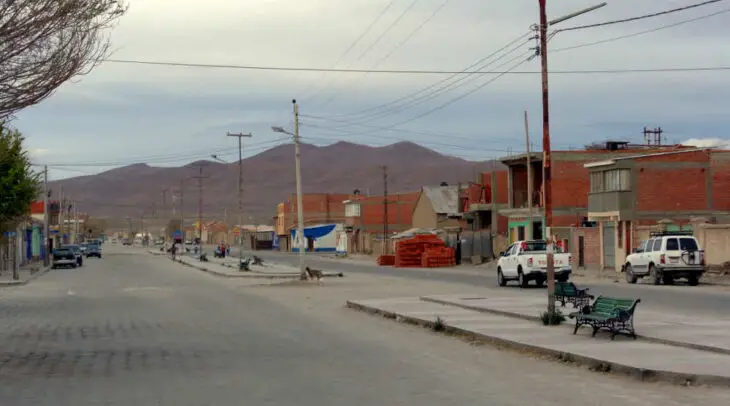
Before I was already awake because the shaking of the bus woke me up. And then I realized that we were driving on sand! This is not surprising in Bolivia as the whole country (which is three times bigger than Germany) only has 3,000 kilometers of paved road. And suddenly you see that there is nothing else – just a huge wide flat. I asked myself, “Do people really live here?”
Around midday we arrived in sleepy Uyuni. So my question was answered: Yes, people do live here! With our backpacks on our backs we looked for a hostel and checked in at Hotel Palace (140 Bolivianos/US$20 double room with private bathroom).
Then we wanted to see more of the town and went for a walk. What can I say? Uyuni is different! Around midday and in the afternoon you have the feeling that not a single soul lives in this town. The streets were almost empty. Houses are brown and grey and the most colorful place is probably Uyuni’s playground.
In the main streets monuments of old locomotives remind of old times when the mining industry had its golden period. But then it all collapsed and the trains were left behind. At least Uyuni still has a functioning train station.
Even after finding some life in the streets in the late afternoon Uyuni looked like a frustrating place to live. But at the same time we were fascinated by its unique atmosphere.
On the next day we started our tour with Cordillera Traveller. A couple from France, Tomas and Lucile, and Amanda and Diego from Brazil also took part in the tour. Our driver packed our 4×4 and in the spacious and comfortable car we all wanted to start the trip.
The Train Cemetery – Looking Back to a Golden Time

As mentioned before trains played a very important role in the history of Uyuni. In the late 19th century minerals were transported from here to the Pacific Ocean. Nowadays you can visit the train cemetery with its wrecked old steam locomotives just 3 kilometers outside of Uyuni. These rusty giants give a little insight into the golden age of this area and it’s a great place for taking pictures.
Salt Museum – Do You Want Some Salt with Your Lunch?
After leaving the village of Colchani we arrived at the salt museum and were surrounded by the white mineral. Salt everywhere! Wow! The reflection of the sun is incredibly strong and without sunglasses you can’t see anything.

The dryness created a beautiful pattern in the salt that is hard as stone.
The Salt Museum used to be a hotel which was illegally run in its beginnings. Almost everything there is made of salt… the walls, the tables, chairs…. It was a special surrounding for having our lunch break. And I am sure nobody missed any salt in the food :).

Photo Time!
It’s so inviting to take funny pictures in the endless salt flat and to play with proportions.
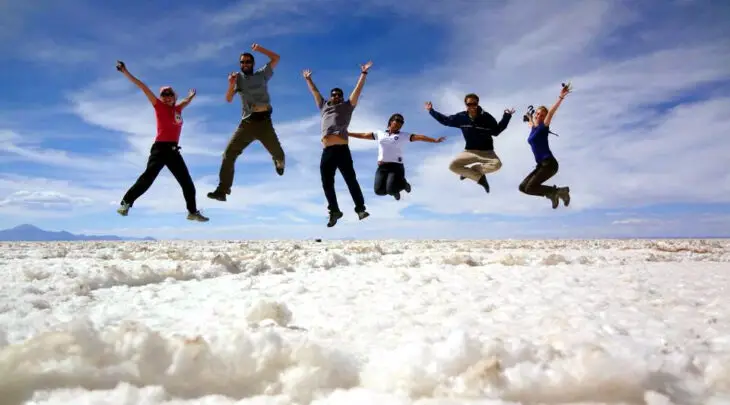
Suddenly you can sit on a Coca Cola tin or your shoes are much bigger than you. I was so proud because the salt made me so strong that Lars could stand on my two hands. It was tough but I made it :). But my absolute favorite shot is Lars great jump over our 4×4.

Isla del Pescado – An Island with No Water Around
Having a shape like a fish from the far distance, Isla del Pescado impresses with its giant cactus. These giants can get an altitude of up to 10 meters! Next to them we looked like little ants. On the island is a path that brings you to the top. From there you have a fantastic view of the many cactus and the huge salt flat.
Salt Hotel – One Night in a Salt Bed
Before sunset our 4×4 arrived at our hotel. Of course it was a salt hotel! Everything was salty… walls, tables, chairs, the floor, and even our beds.

Before the tour started we read that it’s a very basic accommodation and expected the worst. But the room was nice and the bathrooms were very modern and even equipped with hot showers. We enjoyed a delicious dinner and a glass of wine and had a great sleep in our special beds. We loved to stay there and to taste the salt in the air.
Sand, Sand, Sand… – and the End of Bolivia
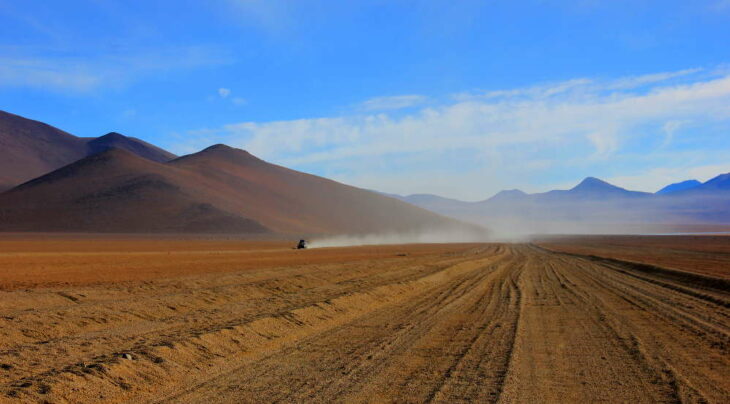
A new day with more natural treasures awaited us. We left the small town where we stayed for the night behind us and in front of us was nothing except sand, stones and volcanoes. Our driver navigated us through a long sand desert where we suddenly spotted a railway track. A railway track? Here? Is this the train to… nowhere??
We learned that this track was still used although it looked like remains from the past. Some kilometers further we could find out by ourselves where the trek goes to…. Chile. We didn’t realize that we reached the end of Bolivia. A sandy lonely border crossing somewhere nowhere…
Welcome to Planet Mars
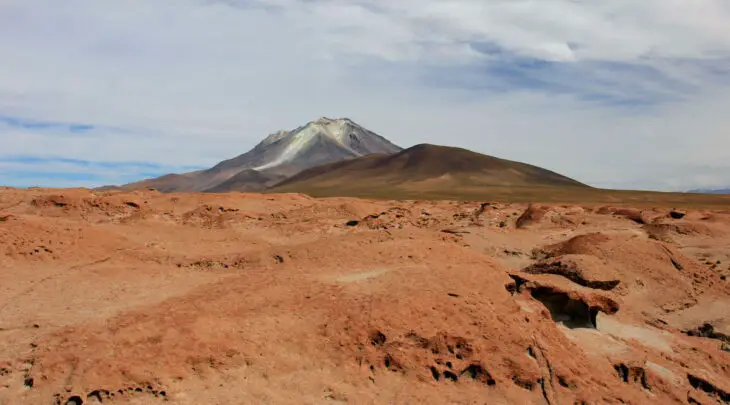
The further our jeep drove, the more we left our planet. I was sure that we had arrived on planet Mars. Well, it’s really the Valley of the Moon, a unique landscape where the sand was red, the rocks took on strange formations and volcanoes dominated the horizon. What a beautiful place!
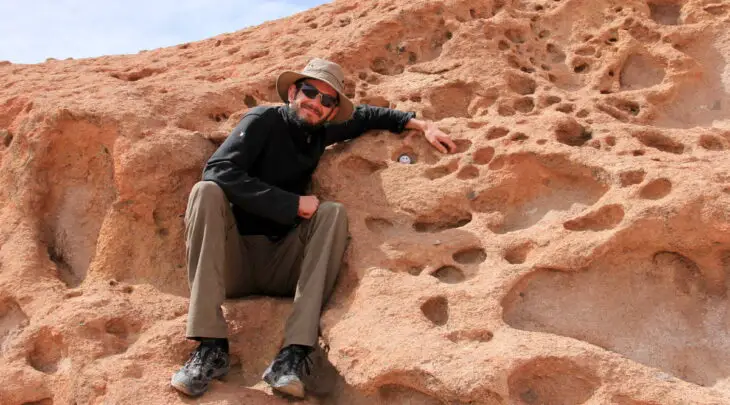
Pink Spots in Beautiful Lagoons – Hundreds of Flamingos
Did you know that flamingos live in high altitudes?
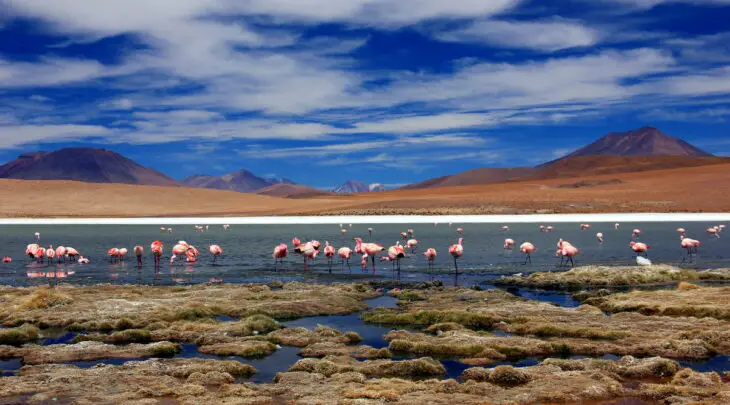
To us it was completely new. Three colorful lagoons awaited us: Canapa, Hedionda and Honda. One was more stunning than the other. The flamingos loved them because they are rich in food. The surrounding was so special that we thought we would be part of a National Geographic documentary :).
Suddenly vicuñas crossed our paths. They belong to the family of the llamas and are very cute and curious.
A Tree as Hard as Stone – Arbol de Piedra
During the trip we had seen a lot of different rock formations. One of the most special formations, and therefore also one of the most famous ones, is the Arbol de Piedra – the stone tree. Through aeolian erosion, due to the sandy environment and strong wind, a formation was formed that looks like a tree. It’s 7 meters high and a very popular photo scene.
A Natural Painting – La Laguna Colorada

The treasures didn’t want to end. We almost reached the point where we couldn’t handle the incredible beauty around us anymore. We had the feeling that we explored a whole new continent in just one day. But it’s “just” a tiny little part of amazing Bolivia.
The last highlight of this day was the amazing Laguna Colorada – the Red Lagoon. It’s not difficult to find out where it got its name from ;). The lagoons we had seen just a few hours before were already fascinating but this one blew our imaginations. Our first thought was “Who put red paint into the water?” Although it’s not just red! The lagoon is red, black, and white and surrounded by brown sand and a deep blue sky. And then there are these little pink spots again, the flamingos. Especially the contrast between the black ground and the pink of the flamingos is beautiful. You have the feeling that you stand in front of a natural painting. The red color comes from certain alga that lives in the water.
A Freezing Night in a Warm Sleeping Bag
The second night we spent in higher altitudes than the night before. The temperatures at night reached 0°C/32°F or less. Our group shared a dorm room with 6 beds. And this was the best that could have happened because it made the room much warmer.

We heard that the second night will be very cold and freezing. We expected the worst but in the end we all had a good sleep. I put on leggings, socks, a t-shirt, a jumper and used our summer sleeping bags additionally to the blankets of the hostel and it was perfect.
The Earth Steams – Geysers at Sunrise
The next day started very early. At 4:30am we had breakfast because we didn’t want to miss the sunrise. Our driver took us to another stunning spot where we would watch the rising sun. It was full of geysers. The whole area was steaming and the air was filled with the smell of sulphur. Mud was boiling and in every hole it was bubbling. The cold air of the morning intensified the steam and the area looked like a mystic place. Wow!
Take a Swim in a Natural Bath Tube
We visited the Termas de Polques, a natural hot spring that is located in the middle of the desert. You want to take a swim? It’s no problem! For a small extra fee you can jump into a pool.
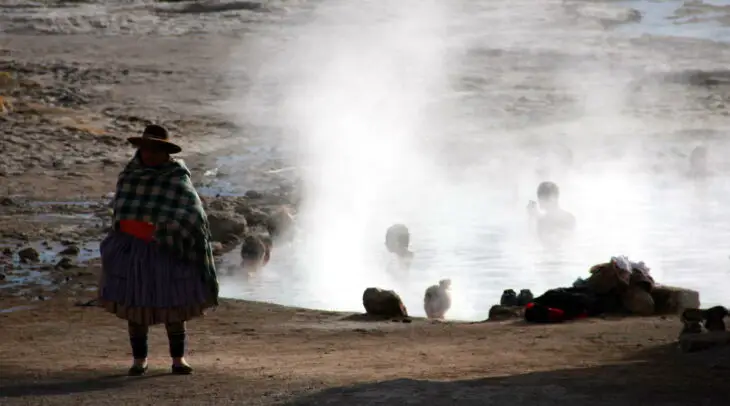
The air is cold but in the pool 30°C/86°F warm water awaits you. As we are not big fans of many people in one pool, we decided to enjoy the surroundings. The whole lake was steaming and it was a beautiful scenery with the birds sitting in the steam. It doesn’t matter what you do, you will like this place.
The Colorful End of the Trip – a Green and White Lagoon
After 2.5 days this great tour came to an end and for the last time we got our cameras ready. The Green Lagoon with the picturesque volcano in the background was a gorgeous last treasure.

The green color of the water also comes from a certain alga. However it’s poisonous and you won’t see any flamingo swagger through the water. Right next to the Green Lagoon is the White Lagoon that, unfortunately, doesn’t get the deserved attention. After so many incredibly colorful lagoons a white one looks somehow inconspicuous.
Right behind this impressive volcano is the border to Chile. It was time to say goodbye to our great driver and the Brazilians. We all were still “high” from all the impressions and the beauty we had seen and couldn’t believe that it was over.
Our Agency and Prices
Uyuni highly depends on tourism and you have the feeling that the main streets only consist of travel agencies. Really, it’s full of them. But which agency offers good value for money? As usual we had a look on tripadvisor before and read many reviews. Unfortunately almost all reviews for the Salar de Uyuni are listed together so that it’s hard to find an overview of the reviews of single companies.
In the end we had three favorites:
- Quechua Connections
- Cordillera Traveller
- Red Planet Expeditions.
All three had very good reviews but didn’t belong to the cheapest agencies. But to be honest, in Bolivia, we never wanted to go for the cheapest, so that these three became our top 3.
When in Uyuni, we went to all three offices and asked for prices and the program. The program is always the same! All jeeps go from highlight to highlight. The differences can be found in the included food and accommodation, the language the guide speaks, and the prices:
1. Quechua Connections: 950 Bolivianos (US$135) per person
2. Cordillera Traveller 900 Bolivianos (US$127) per person
3. Red Planet Expeditions 1,200 Bolivianos (US$169) per person.
All tour operators DO NOT include the following extra fees: Entrance Isla del Pescado: 30 Bolivianos per person and Entrance Eduardo Avaroa National park: 150 Bolivianos per person. All tour operators DO INCLUDE the transfer to Chile’s San Pedro de Atacama if you don’t want to go back to Uyuni (Bring money! Border crossing fee to Chile is 15 Bolivianos per person).
The reasons why we chose Cordillera Traveller: Red Planet Expeditions were fully booked for the next day and they were more expensive because of the English speaking guide. As this doesn’t matter to us we decided not to go for the most expensive one. The office of Quechua Connection was closed the whole day and we weren’t sure if they would open in the evening. So we decided to be on the safe side and booked with Cordillera Traveller. At 18:30 pm we saw that the Quechua Connection office just opened but then the tour was already booked.
Of course I can’t compare the tours with each other but I recommend Cordillera Traveller! Our whole group was very satisfied with the tour: very good and comfortable 4×4, experienced driver, always good food, good accommodation. Just one thing could have been better: Our driver was also our guide and didn’t talk that much in the beginning so we had to ask for information. But on the second day it was all good. All in all the tour offered everything we wanted and even more.
By the way, the same operators offer tours from Chile’s San Pedro de Atacama. Cordillera Traveller offers the same tour for US$185 per person. On their website (see link above) they do not communicate the cheaper Bolivian price!
Wrapping Up the Bolivia Salt Flats Adventure
You know, the Bolivia Salt Flats isn’t just a pretty face. Sure, it’s a jaw-dropping sight, but there’s so much more to it. It’s like stepping into a time machine, with stories going back thousands of years.
And then there’s the little town of Colchani, bustling with folks who make a living from this vast white desert. It’s amazing how a place can be both a photographer’s dream and a history buff’s paradise. So, if you’re thinking of a trip that’s a bit off the beaten path and packed with cool stories, this is it.
Trust me; it’s an adventure you won’t forget anytime soon.
Frequently Asked Questions
What is the optimal time of year to visit the Uyuni salt flats?
The best time to visit the Uyuni salt flats in Bolivia is from December to April during the wet season. During this time, the salt flats transform into a massive mirror, reflecting the sky, and creating a surreal and breathtaking experience.
How many days should we plan for a Bolivia salt flats tour?
We recommend planning for at least a three-day tour of the Bolivia salt flats to experience the region’s highlights, including the Uyuni salt flats, the Red Lagoon, and the Eduardo Avaroa Andean Fauna National Reserve.
Are the Bolivia salt flats worth visiting?
Absolutely. The Bolivia salt flats are one of the most unique and beautiful landscapes in the world, offering a once-in-a-lifetime experience. The vast expanse of salt, the mirror effect during the wet season, and the stunning natural beauty of the surrounding areas make it an unforgettable destination.
What is the weather like at the Uyuni salt flats?
The weather at the Uyuni salt flats can vary greatly depending on the season. During the wet season (December to April), the weather is mild, with temperatures ranging from 15-20°C (59-68°F) during the day and dropping to 0-5°C (32-41°F) at night. During the dry season (May to November), temperatures can range from 20-25°C (68-77°F) during the day and drop to -5-0°C (23-32°F) at night.
What is the dry season like at the Bolivia salt flats?
The dry season at the Bolivia salt flats is from May to November. During this time, the weather is generally sunny and dry, with clear blue skies and low humidity. This season is ideal for photography and exploring the region, as there are fewer crowds and lower prices than during the wet season.
What is the wet season like at the Bolivia salt flats?
The wet season at the Bolivia salt flats is from December to April. During this time, the region experiences heavy rainfall, which creates the famous mirror effect on the salt flats. The weather is mild and humid, with occasional thunderstorms. The wet season is the peak tourist season, so expect higher prices and larger crowds.
About the Author

Liane, Lars, and BoB
Liane, Lars, and their unique travel companion, BoB, are the adventurous trio behind the hit travel blog, "BoB around the world." With over 2 years on the road, they've embraced diverse cultures, witnessed breathtaking landscapes, and shared their tales with the world. Their passion for travel and storytelling led them to join the staff of writers at TraveLover Planet, further amplifying their inspiring stories.
